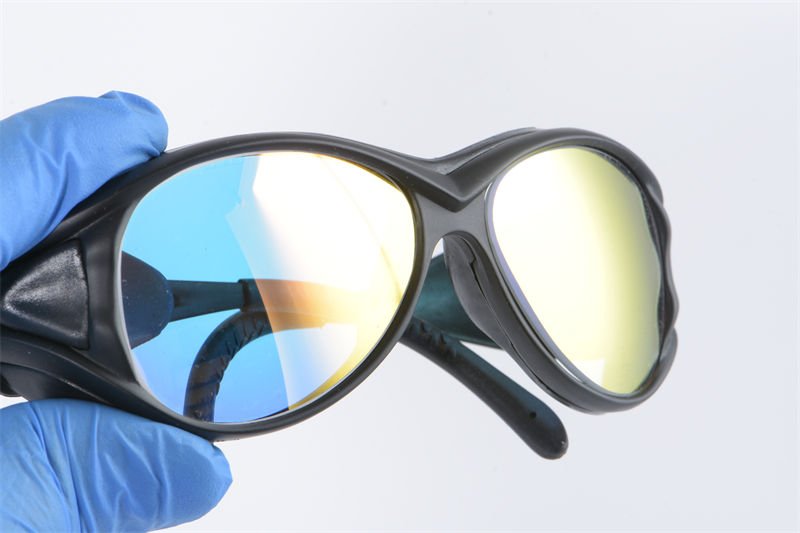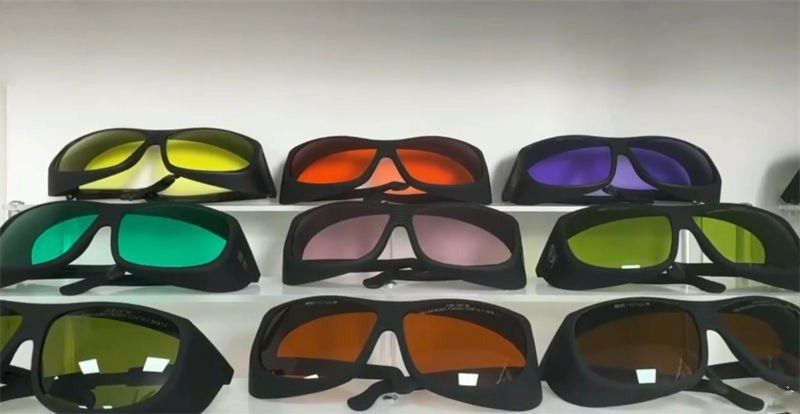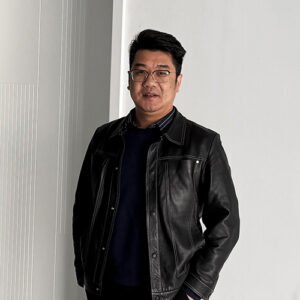
When it comes to laser engraving, protecting my eyes is not just smart—it’s essential. I’ve learned that choosing the right protective glasses can make all the difference between a safe experience and a dangerous one.
The best protective glasses for laser engraving should have an appropriate Optical Density (OD) rating tailored to your laser’s specific wavelength and power. Additionally, they must comply with safety standards like ANSI Z136 to effectively block or filter the laser light.
But finding the perfect pair isn’t just about numbers. Let’s dive deeper into what you really need to consider, from laser specs to comfort—because your safety and comfort matter.
Optical Density (OD) is crucial for laser safety glasses.True
OD measures the attenuation of laser light, ensuring eye protection.
How Does Optical Density Affect Laser Protection?
Optical Density (OD) plays a crucial role in determining the effectiveness of laser protective goggles, ensuring safe use during industrial applications.
Optical Density (OD) measures the attenuation of laser light by protective goggles, indicating their capacity to reduce laser power density to a safe level for human eyes. A higher OD value offers greater protection against potential eye damage from laser exposure.

The Importance of Optical Density in Laser Protection
Understanding Optical Density1 is essential when selecting laser safety goggles. OD values range from OD1 to OD10, each step representing a tenfold decrease in laser intensity reaching your eyes. For instance, goggles with an OD of 3 reduce the laser’s power to one-thousandth of its original intensity.
Calculating Required Optical Density
To determine the necessary OD, consider the laser’s power density and the Maximum Permissible Exposure (MPE) level. The formula:
[
OD = \log_{10} \left(\frac{\text{Laser Power Density}}{\text{MPE}}\right)
]
This calculation helps ensure the goggles provide adequate protection by reducing the laser light intensity to a safe exposure level. For example, if a laser’s power density is 10,000 times greater than the MPE, an OD of 4 is necessary to make it safe for your eyes.
Optical Density and Wavelength Specificity
The effectiveness of OD is also wavelength-specific. Goggles designed for a certain wavelength might not provide the same protection for another. It’s crucial to match the goggles’ OD rating with the laser’s specific wavelength to avoid insufficient protection.
OD Value vs. Optical Grade (OG)
While focusing on OD, don’t overlook Optical Grade2. Higher OG values improve visibility through the goggles but might compromise protection levels. Striking a balance between visibility and safety is vital.
Practical Considerations in Industrial Settings
In environments with high-intensity lasers, like those used in metal cutting or engraving, using goggles with appropriate OD ratings is non-negotiable. Regularly evaluate whether your equipment meets updated safety standards and inspect your goggles for any wear or damage that might affect their efficacy.
Higher OD values offer more laser protection.True
Higher Optical Density (OD) values reduce laser intensity more effectively.
OD is not wavelength-specific in laser goggles.False
OD effectiveness varies with wavelength; goggles must match laser wavelength.
What Laser Specifications Should I Consider?
Choosing the right laser goggles requires understanding key specifications of your laser equipment to ensure optimal protection.
Consider the laser’s wavelength and power output when selecting safety goggles. These factors determine the goggles’ ability to block or filter harmful laser light effectively. Always check that they meet safety standards like ANSI Z136 to ensure comprehensive protection.

Understanding Laser Wavelengths and Power Output
When selecting protective goggles, the laser wavelength3 is a primary factor. The wavelength determines the type of light emitted, and each type requires specific filtering capabilities. For instance, lasers emitting in the ultraviolet (UV) range require different goggles than those operating in the infrared (IR) spectrum.
Additionally, the power output of your laser is critical. High-power lasers pose more risk and require goggles with higher Optical Density (OD) ratings to ensure adequate protection.
Compliance with Safety Standards
Ensure that the goggles adhere to established safety standards such as ANSI Z136. This standard outlines the minimum requirements for laser safety, including the necessary protection levels for different laser classes and environments.
Consideration of Environmental Factors
The environment in which the laser is used can influence the specifications needed for protective goggles. For instance, in high-reflectivity settings like metalwork shops, selecting goggles with anti-reflective coatings can be beneficial.
Importance of Additional Features
Beyond the basic specifications, consider additional features such as anti-fogging coatings and adjustable fits. These can enhance usability and comfort, ensuring that safety does not come at the expense of convenience.
Understanding these laser specifications is crucial for selecting appropriate protective gear that balances safety, functionality, and comfort. For more detailed insights into choosing the right goggles based on specific laser types, consider exploring expert guides and product reviews.
Laser goggles must meet ANSI Z136 standards.True
ANSI Z136 outlines necessary protection levels for laser safety.
All laser goggles protect against UV and IR light.False
Goggles are wavelength-specific; UV and IR need different filters.
Are There Specific Safety Standards for Laser Goggles?
Ensuring safety in laser operations starts with understanding the specific standards governing laser goggles. These standards are crucial for preventing eye injuries.
Laser goggles must meet safety standards such as ANSI Z136 and EN 207, which specify requirements for protection against laser radiation, ensuring they effectively block or filter harmful wavelengths.

Understanding Key Laser Safety Standards
When selecting laser goggles, it’s essential to ensure compliance with recognized safety standards. These standards are designed to safeguard users from potential hazards associated with laser radiation.
-
ANSI Z136 (United States): The American National Standards Institute (ANSI) Z136 series provides comprehensive guidelines for safe use of lasers. This includes specifying the necessary Optical Density4 (OD) ratings required for different classes of lasers and ensuring that protective eyewear can withstand direct exposure without degradation.
-
EN 207 (Europe): The European standard EN 207 details the specifications for laser protective goggles. It includes testing requirements to ensure that the goggles can withstand specified wavelengths and power levels, offering adequate protection in various scenarios.
Compliance and Testing Procedures
Adhering to these standards requires thorough testing of laser goggles:
-
Wavelength Range: Goggles must be tested for effectiveness across a specified wavelength range to ensure that they can block or filter the intended laser light. For example, goggles used in medical settings often require protection against multiple laser types.
-
Resistance to Laser Power: The ability of goggles to resist high-power lasers without failing is crucial. This involves evaluating the material’s resistance to thermal and photochemical damage, often using controlled exposure tests.
Importance of Certification Labels
-
Certification Markings: Always check for certification markings on laser goggles. These labels confirm that the product meets relevant safety standards and has passed rigorous testing.
-
Detailed Specifications: Certification should include detailed information about the OD rating, wavelength protection range, and applicable standards. This information helps users select the appropriate goggles for their specific needs.
Industry Application and Best Practices
Industries using high-powered lasers, such as manufacturing and healthcare, must prioritize safety by ensuring all personnel use certified protective eyewear. Here are a few best practices:
-
Regular Training: Provide comprehensive training on laser safety and the proper use of protective equipment to all employees.
-
Routine Inspections: Conduct regular inspections of all protective gear to identify wear and tear or potential failures.
By adhering to these safety standards, industries can significantly mitigate risks and ensure a safer working environment for all involved in laser operations.
Laser goggles must meet ANSI Z136 standards.True
ANSI Z136 provides guidelines for laser safety, including eyewear.
EN 207 is a US standard for laser goggles.False
EN 207 is a European standard, not a US standard.
Why Is Comfort Important When Choosing Laser Safety Glasses?
Comfort is crucial when selecting laser safety glasses because it affects usability, wear time, and ultimately, safety compliance.
Comfort in laser safety glasses ensures prolonged wear without discomfort, preventing exposure to harmful laser radiation. Proper fit reduces distractions and enhances focus, crucial for tasks requiring precision.

The Impact of Fit on Safety
When it comes to laser safety eyewear5, ensuring a secure and comfortable fit is paramount. Glasses that fit well are more likely to be worn consistently, reducing the risk of accidental exposure. A snug fit prevents gaps where laser light might penetrate, maintaining the integrity of the protection offered.
The Role of Material and Design
The materials used in the frame and lenses contribute significantly to comfort. Lightweight materials like polycarbonate reduce the strain on the face and ears during extended use. Additionally, ergonomic designs with adjustable nose pads and temple arms provide a customizable fit that caters to individual needs, accommodating various head sizes and shapes.
Psychological Aspects of Wearing Comfort
Comfort extends beyond physical attributes; psychological comfort also plays a role. Users who find their eyewear cumbersome or uncomfortable may be tempted to remove it frequently, increasing the risk of eye injuries. In contrast, comfortable glasses are less intrusive, allowing users to concentrate better on their tasks without constant adjustments or interruptions.
Balancing Comfort with Protection
While comfort is important, it should not compromise safety. It’s essential to strike a balance between a comfortable fit and adequate protection. Opt for glasses that meet safety standards while offering comfort features such as cushioned frames and anti-fog coatings. This balance ensures you remain protected without sacrificing ease of wear.
Considerations for Different Work Environments
In some industrial settings, environmental factors such as temperature and humidity can affect comfort. In high-temperature areas, glasses with ventilation features can prevent fogging and heat buildup. Conversely, in low-temperature environments, selecting glasses with insulation properties can enhance comfort and usability.
Ultimately, prioritizing comfort when selecting laser safety glasses not only enhances the user experience but also ensures consistent compliance with safety protocols.
Comfort affects wear time of laser safety glasses.True
Comfortable glasses are worn longer, enhancing safety compliance.
Material choice doesn't impact comfort in laser eyewear.False
Lightweight materials like polycarbonate enhance comfort and usability.
Conclusion
In essence, by prioritizing Optical Density, understanding your laser’s specifications, and adhering to safety standards, you can select protective glasses that ensure both safety and comfort during your engraving projects.
-
Understanding Optical Density helps ensure appropriate eye protection from lasers.: Optical Density = Log (Maximum Power Density Output/ Maximum Permissible Exposure). *Where Maximum power density output and Maximum permissible exposure are … ↩
-
Optical Grade impacts both visibility and protection efficacy in laser goggles.: A higher OD rating indicates greater protection. Generally, an OD of 5 or higher is recommended for powerful lasers. ↩
-
Learn how different wavelengths affect the choice of protective goggles.: This laser wavelength chart indicates the available power (and energy) levels by the length of the lines. The scale is on the left-hand side. ↩
-
Learn about Optical Density’s role in laser eye protection.: Optical Density = Log (Maximum Power Density Output/ Maximum Permissible Exposure). *Where Maximum power density output and Maximum permissible exposure are … ↩
-
Discover why comfort increases compliance and ensures consistent protection.: These glasses offer a snug fit, ensuring they feel comfortable on the face. The rubber nose bridge prevents red marks or sores, and you can even choose from … ↩



